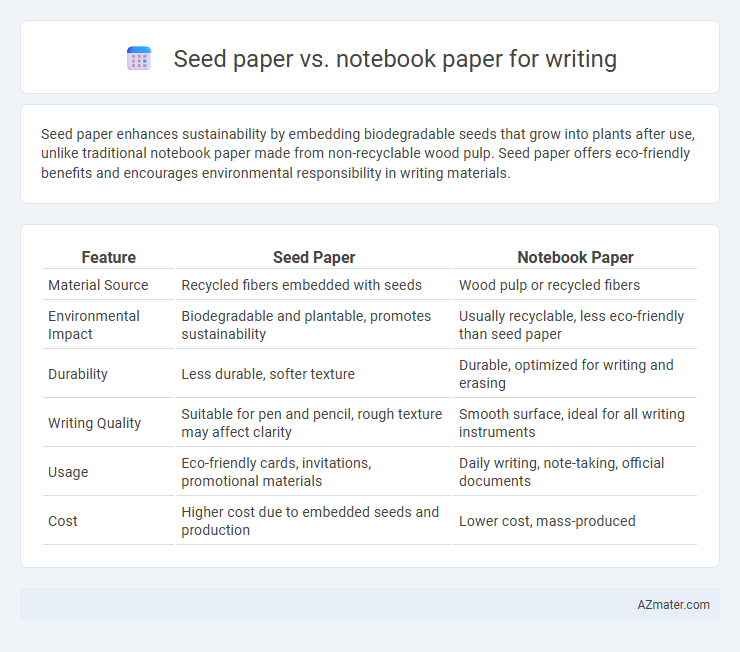Seed paper enhances sustainability by embedding biodegradable seeds that grow into plants after use, unlike traditional notebook paper made from non-recyclable wood pulp. Seed paper offers eco-friendly benefits and encourages environmental responsibility in writing materials.
Table of Comparison
| Feature | Seed Paper | Notebook Paper |
|---|---|---|
| Material Source | Recycled fibers embedded with seeds | Wood pulp or recycled fibers |
| Environmental Impact | Biodegradable and plantable, promotes sustainability | Usually recyclable, less eco-friendly than seed paper |
| Durability | Less durable, softer texture | Durable, optimized for writing and erasing |
| Writing Quality | Suitable for pen and pencil, rough texture may affect clarity | Smooth surface, ideal for all writing instruments |
| Usage | Eco-friendly cards, invitations, promotional materials | Daily writing, note-taking, official documents |
| Cost | Higher cost due to embedded seeds and production | Lower cost, mass-produced |
Introduction to Seed Paper and Notebook Paper
Seed paper integrates biodegradable fibers embedded with seeds, enabling users to plant the paper after use, promoting sustainability and eco-friendly practices. Notebook paper, typically made from processed wood pulp, serves as a conventional writing surface designed for durability, smoothness, and compatibility with various ink types. These distinct materials influence both environmental impact and writing experience, with seed paper offering a unique green alternative to standard notebook paper.
Environmental Impact: Seed Paper vs Notebook Paper
Seed paper significantly reduces environmental impact by integrating biodegradable materials embedded with seeds that promote plant growth after use, thus supporting reforestation and reducing landfill waste. Notebook paper production requires extensive deforestation, water, and chemical use, contributing to habitat loss, pollution, and carbon emissions. Choosing seed paper over traditional notebook paper helps conserve natural resources and enhances sustainability efforts through eco-friendly lifecycle benefits.
Material Composition and Manufacturing Process
Seed paper consists of recycled fibers embedded with biodegradable seeds, combining eco-friendly pulp and natural fertilizer elements that promote plant growth when planted. Notebook paper typically uses virgin or recycled wood pulp processed through conventional pulping and bleaching methods, prioritizing smoothness and opacity for writing clarity. The manufacturing of seed paper integrates seed embedding during the sheet-forming stage, whereas notebook paper emphasizes mass production techniques focused on uniform thickness and surface finish.
Writing Experience: Texture and Ink Absorption
Seed paper offers a unique textured surface that enhances tactile engagement but may cause uneven ink absorption, potentially leading to slight smudging or bleeding with some pens. Notebook paper typically features a smoother finish, promoting consistent ink distribution and crisp, clean lines ideal for daily writing tasks. Writers seeking a natural, eco-friendly feel might prefer seed paper despite minor challenges, while those prioritizing precision and legibility often favor traditional notebook paper for its reliable writing performance.
Durability and Longevity
Seed paper typically has lower durability and longevity compared to notebook paper due to its biodegradable materials designed to break down when planted. Notebook paper, made from processed wood pulp and sometimes reinforced with coatings, retains quality over extended periods, making it more suitable for long-term writing preservation. The trade-off involves seed paper's eco-friendly benefits but reduced resistance to wear and tear, whereas notebook paper offers sturdiness and durability for archival purposes.
Biodegradability and Sustainability
Seed paper is highly biodegradable and promotes sustainability by embedding seeds that can grow into plants after use, significantly reducing waste and environmental impact compared to traditional notebook paper. Notebook paper, typically made from wood pulp and often containing chemical treatments, degrades more slowly and contributes to deforestation and pollution. Choosing seed paper supports regenerative practices and a circular economy, making it a superior eco-friendly alternative for writing materials.
Cost Comparison: Seed Paper vs Notebook Paper
Seed paper typically costs more than standard notebook paper due to its eco-friendly materials and embedded seeds designed for planting, which adds value and production complexity. Notebook paper, made from conventional wood pulp, is generally cheaper and widely available in bulk, making it a cost-effective choice for everyday writing. However, seed paper offers long-term environmental benefits that may justify the higher initial price for sustainable consumers.
Aesthetic Appeal and Design Options
Seed paper features unique, embedded seeds creating a textured surface with natural, organic patterns enhancing aesthetic appeal and offering eco-friendly design versatility. Notebook paper provides a smooth, uniform surface ideal for consistent handwriting and comes in various ruled, grid, and blank formats supporting diverse design preferences. Both options allow customization, but seed paper stands out for its artistic, environmentally conscious look while notebook paper excels in functional design adaptability.
Ideal Use Cases for Seed Paper and Notebook Paper
Seed paper is ideal for eco-conscious projects such as wedding invitations, promotional materials, and gift tags because it can be planted to grow flowers or herbs, enhancing sustainability efforts. Notebook paper is better suited for daily note-taking, academic work, or office tasks where durability, ease of writing, and reusability are essential. Seed paper's delicate texture limits extensive writing, making it less practical for heavy use compared to the smooth, sturdier surface of traditional notebook paper.
Choosing the Best Paper for Your Writing Needs
Seed paper offers an eco-friendly choice by embedding plant seeds within biodegradable paper, ideal for sustainable writing projects that promote environmental consciousness. Notebook paper provides a smooth, consistent surface optimized for everyday writing, note-taking, and academic use, ensuring clarity and durability. Selecting the best paper depends on whether you prioritize sustainability and creativity with seed paper or functionality and tradition with standard notebook paper.

Infographic: Seed paper vs Notebook paper for Writing
 azmater.com
azmater.com